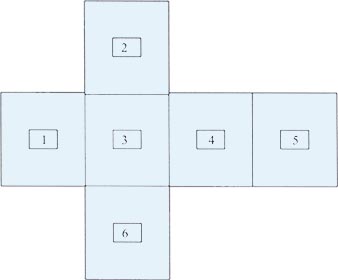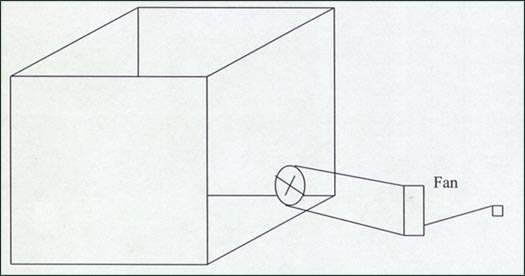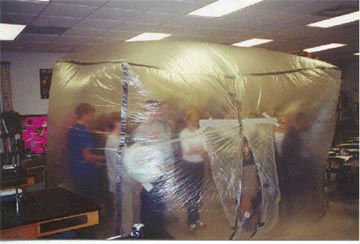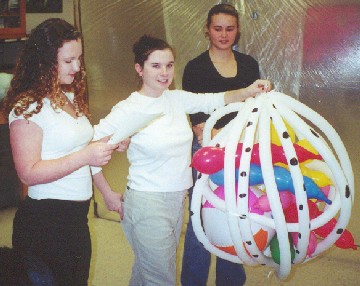Biology Students
and the Giant Plant Cell by Judith
D. Jones
East Chapel Hill High School
Teacher Introduction:
A traditional activity in a high school biology class is to have students
create cell models. I have found that one drawback to this activity is
that the organelles are always greatly enlarged relative to the size of
the cell. A similar problem exists with cell diagrams in textbooks. Students
are misled into thinking that the organelles are very large. The following
activity involves students in creating organelles to scale for a Giant
Plant Cell (approximately 3 meters on each side) made out of clear plastic
painter's drop cloths and inflated with inexpensive portable fans (see
provided instructions for making the big cell). Students use ratios in
order to determine how large their organelles should be--a good integration
of math into the biology curriculum (student activity included).
This activity has several advantages. Students are engaged in very active
learning and they enjoy the mystery surrounding the arrival of the Giant
Cell.** They can conduct their research using many sources, including
the Internet. They must problem solve as they decide what size their organelles
need to be and what materials will best represent the infrastructure of
the organelles. They collaborate to prepare an interesting presentation
for the rest of the class which taps into their ability to communicate
and their creativity. After students have been actively involved in problem
solving, they make a very intent audience for their peers because they
are intrigued by how other people solved similar problems. The students
come away with a very clear visual image of the proportions of cell parts
and the functions of these structures.
Suggested Classroom Activities
- Students are presented
with the problem of "The Giant Plant Cell." Students are organized into
groups of two or three. Each group signs up for an organelle.
- nucleus and nucleolus
- mitochondrion
- chloroplast
- rough endoplasmic reticulum
(focus on function of ribosome)
- smooth endoplasmic reticulum
(focus on function of ER)
- Golgi complex
- lysosomes
- peroxisomes
- microtubules and microfilaments
- vacuole
- Students research the structure
and function of their chosen organelle.
- Students produce a blueprint
describing how they will construct their model and its size.
- Students prepare a class
presentation.
- The Giant Plant Cell arrives
and students present their organelles.
- As students are presenting,
other class members are taking notes on the presentations. The focus
of these notes is the structure of each organelle, its function, and
its role in the total functioning of the cell.
** The excitement is increased
if the large inflated "cell" does not appear until the day of the presentation.
Helpful Notes:
- Some cell parts, such as
the endoplasmic reticulum, microtubules/microfilaments, and vacuole
are found extensively throughout the cell. Students should just make
a section of such cell structures and then discuss in their presentations
how extensive these structures are in the cell.
- Lessons on the cell wall
and plasma membrane can be taught by the teacher. I explain that the
drop cloth represents the plasma membrane and the ceiling and floor
and one wall (which the drop cloth touches) represents the cell wall.
Then I do the lessons on the functions of these structures including
osmosis labs, etc.
- For students who need less
direction, you can have them construct the cell and decide how they
are going to create organelles to scale. Leave the discovery of the
mathematical applications up to them. The instructions are precise.
However, it is
preferable to have students do as much of the problem solving as possible.
Following are:
- Student instructions for
constructing organelles to scale
- A rubric for evaluating
the student projects
- A chart of actual organelle
sizes (taken from various sources); students should do their own research)
- Suggested questions for
processing and/or evaluation
- Instructions for building
the giant plant cell
The Story! You can create your own tale of the visit of the Giant
Cell and how it lost its organelles. I enjoy spinning a new tale each year.
One year I conjured up a "mad scientist" who had been experimenting with
cells and with a machine that took microscopic things and created giants.
Have fun with this! You can build the suspense and create interest. Don't
tell them what the cell will look like - other than its dimensions.
Creating the Organelles The Giant Plant Cell is shaped like a giant
cube that is 3 meters (300 cm) on each edge. You have been provided with
a chart of actual cell organelle sizes. You must, using ratios, calculate
the size of your giant organelle so that it is proportionately correct for
the huge cell. You also need to research the function of the organelle in
order to build it so that it can carry out its role in the giant cell. First,
you will prepare an architectural design plan that will be evaluated by
your teacher. Then you will build your organelle. You will prepare a 3-5
minute report to present to the class. Your organelle will be judged according
to the accuracy of its size, the correctness of its details, your explanation
of its function and your creativity.
Equation for determining size of organelle:
| Size of
giant organelle |
= |
Actual
size of organelle |
| Size of
giant cell (300 cm) |
= |
Actual
size of average plant cell (30mm) |
Organelle Architectural Design Sheet
Names of Design Team
__________________ __________________ ________________
Name of Organelle _______________________
Equation for determining the dimensions of giant organelle:
List of Materials Needed to Construct Organelle:
Diagram Showing Construction Plan:
Plan for Division of Labor Among Construction Team:
Grading Rubric for Colossal Plant Cell Organelle
Basic Requirements
- Construction of Organelle
- All constructed organelles
must be 3-dimensional.
- All organelles must
show internal and external details.
- All organelles must
be the correct size for the colossal plant cell.
- Oral Presentation
- Reports should be about
3-5 minutes long.
- Each member of the
team should do part of the presentation.
- The presentation should
include details about the organelle's structure and function.
- The presentation should
include a discussion about how many of the organelles will be manufactured
for the colossal plant cell.
- The presentation should
also include an explanation of the actual and giant size of the
organelle.
RUBRIC USED FOR
EVALUATION
(This should be given to the students at the beginning of the project.)
Note: The words (unacceptable, passing, acceptable, competent, and excellent)
are used instead of A, B, C, D, and F.
| Points |
Criteria |
Unacceptable |
Passing |
Acceptable |
Competent |
Excellent |
| 30 |
detail
-accuracy of the model |
There
is no model or the structural details are completely wrong |
A few
of the structural details represented accurately |
Most
of the structural details are represented; some of them accurately |
All
of the relevant structural details are represented; most accurately |
The
structural details are all well represented and very accurate. |
| 15 |
quality
of presentation - explanation of structure and model |
Explanation
of structure is inaccurate and incomplete; no reference to model
made |
Explanation
of structure is incomplete; very little reference to model |
Explanation
of structure is good; very little reference to model |
Explanation
of structure is good; there is reference to model |
Explanation
of structure and reference to model are accurate, integrated and
clear |
| 15 |
Quality of presentation
- explanation of function of structure |
Presentation is
unclear and does not cover requested information |
Presentation does
not cover all of the material; much of it is read |
Presentation covers
all of the relevant material; much of it is read |
Presentation covers
all of the relevant material; very little of it is read |
Presentation covers
all relevant material; it is presented in a lively interesting
fashion |
| 20 |
individual participation |
Only one person
in the group does the presentation; the parts may be connected
or not |
One person does
more than 70% of the presentation and the parts are presented
separately |
One person does
60-70% of the presentation; the parts are presented separately |
Only one of the
following is present; equal participation or connected parts |
Both people participate
equally; the parts are well connected |
| 10 |
size accuracy of
the model |
Size is 100% too
big or too small. |
Size is 75% too
big or too small |
Size is 50% too
big or too small |
Size is 25% too
big or too small |
Size is within 25%
of being correct |
| 10 |
creativity |
No evidence of creativity |
There is some evidence
of an attempt to be creative but it is not executed well |
There are a few
creative details in the model or report |
There are several
creative details in the model and report |
The entire project
shows evidence of creative thinking - both creation of the model
and presentation. |
| 100 |
Total |
|
|
|
|
v |
Note: If a criterion is worth 30 points, then the numbers above the column
chosen would be multiplied by 3. If the criterion is worth 20 points, then
the number would be multiplied by 2.
Comments from Evaluator
** It is better if the students do their own research on these sizes,
but the chart can be used if teachers are short on time.
CHART OF ACTUAL ORGANELLE SIZES
Cell or Organelle |
Size in x (10-3 mm |
| Average
Plant Cell |
30 x |
| Nucleus |
7.5-10 x |
| Nucleolus |
2.5 x |
| Plasma
Membrane |
0.009 x thick |
| Mitochondrion |
0.2-1 x wide x 3-10 x long |
| Chloroplast
(other plastids are similar sizes) |
2 x
5 x |
| Ribosome |
0.025 x |
| Endoplasmic
Reticulum (in most plant cells) |
0.5 x thick (2 membranes of 0.009 mm with 0.03 mm compartment between
them) |
| Golgi
Complex (dictyosome in plant cells) |
1 x 1 x (membranes have
thickness of ER) |
| Vacuole
(central) sometimes serves as lysosome |
50-80%
of volume of cell |
| Microtubules |
0.02 x diameter |
| Microfilaments |
0.007
0.5-1 x diameter |
| Lysosomes
(in some plant cells) |
0.2-2 x |
| Peroxisomes |
3 x |
| Cell
Wall |
1-2 x thick |
Questions That May Be Used for Processing or for Evaluation of Understanding
- How is a typical plant
cell the same as a prokaryotic cell? How is a typical plant cell
different from a prokaryotic cell?
- How are plant and animal
cells similar? How are plant and animal cells different?
- Discuss the interaction
of the mitochondria and the chloroplasts. What substances do each produce
that the other uses?
- Given the size of the organelles,
which structures would you expect to see with a typical light microscope
(magnifies 400x)? Explain your reasoning.
- How would a plant cell
found in the petal of a flower be different from/similar to a "typical
plant cell" such as the Giant Plant Cell?
- If the giant plant cell
was a leaf cell, describe what you would need to add to the cell to
help it function.
- Describe how proteins are
synthesized in a plant cell.
- How is the cellular structure
of terrestrial plants different from that of aquatic plants?
- If you were looking at
a root cell, a leaf cell, and a stem cell what differences would you
find?
- How is carbon cycled in
a plant? In a plant cell?
- What happens to the molecules
that are formed by the chloroplasts?
- What happens to the molecules
that are formed by the mitochondria?
Instructions for Making the
Colossal Cell
 |
Each square is a 3m x 3m section of plastic painter's drop cloth;
the squares are taped together down each seam with duct tape.
The left hand sides
of sections 2 and 6 are taped to section 1 and the right hand
sides of sections 2 and 6 are taped to section 4; section 5
covers the top and is taped to sections 2, 6, and 1; now you
have a cube. |
 |
In one
end of the cube, cut a slit to act as a door; tape all the edges
of the slit. Hang a drape of extra drop cloth on the inside to
cover the slit; this
will keep air from escaping when you inflate the cell. |
 |
On the
back of the cell, tape a tube of painter's drop cloth; tape one
end of the tube around a fan so that the air blows into the cell.
Cut an "X" into the cell so that the air can blow into it.
|
Acknowledgements and Bibliography
Thanks to Richard Benz at Wickliffe High School in Ohio for the original
idea for building a giant cell.
Thanks to Joe Lapiana in Massachusetts for the idea of putting an extra
flap of plastic inside the doorway to prevent air loss.
Thanks to my colleague Gail Boyarsky for her generous enthusiasm in helping
to carry out the activity.
Thanks to three years of UNC student teachers for their additions to the
actual classroom activities - Christie Dobbin, Neeli Lambert, Christy Boylston,
and Krista Blanton.
Bibliography
Curtis, Helena and Barnes, N. Sue (1989). Biology, 5th edition. New York:
Worth Publishers, Inc.
Campbell, Neil A. (1993). Biology, 3rd edition. Redwood City. The Benjamin/Cummings
Publishing Company, Inc.
Biological Science: An Ecological Approach, 7th edition (1993). Biological
Sciences Curriculum Study. Dubuque. Kendall/Hunt Publishing Company.

Here is the entire class in the cell, comparing the sizes of their organelle
models to the complete cell. While in the cell, I will explain how molecules
get in and out of actual cells.

Here is a sample organelle. This is a wonderful nucleus. Note the black
dots that represent nuclear pores on the nuclear envelope (skinny white
balloons). The spiral balloons are the chromosomes - nice spiral touch.
And the beach ball is the nucleolus - perhaps a little large. But this organelle
showed very nice thinking and creativity in choice of materials.
|